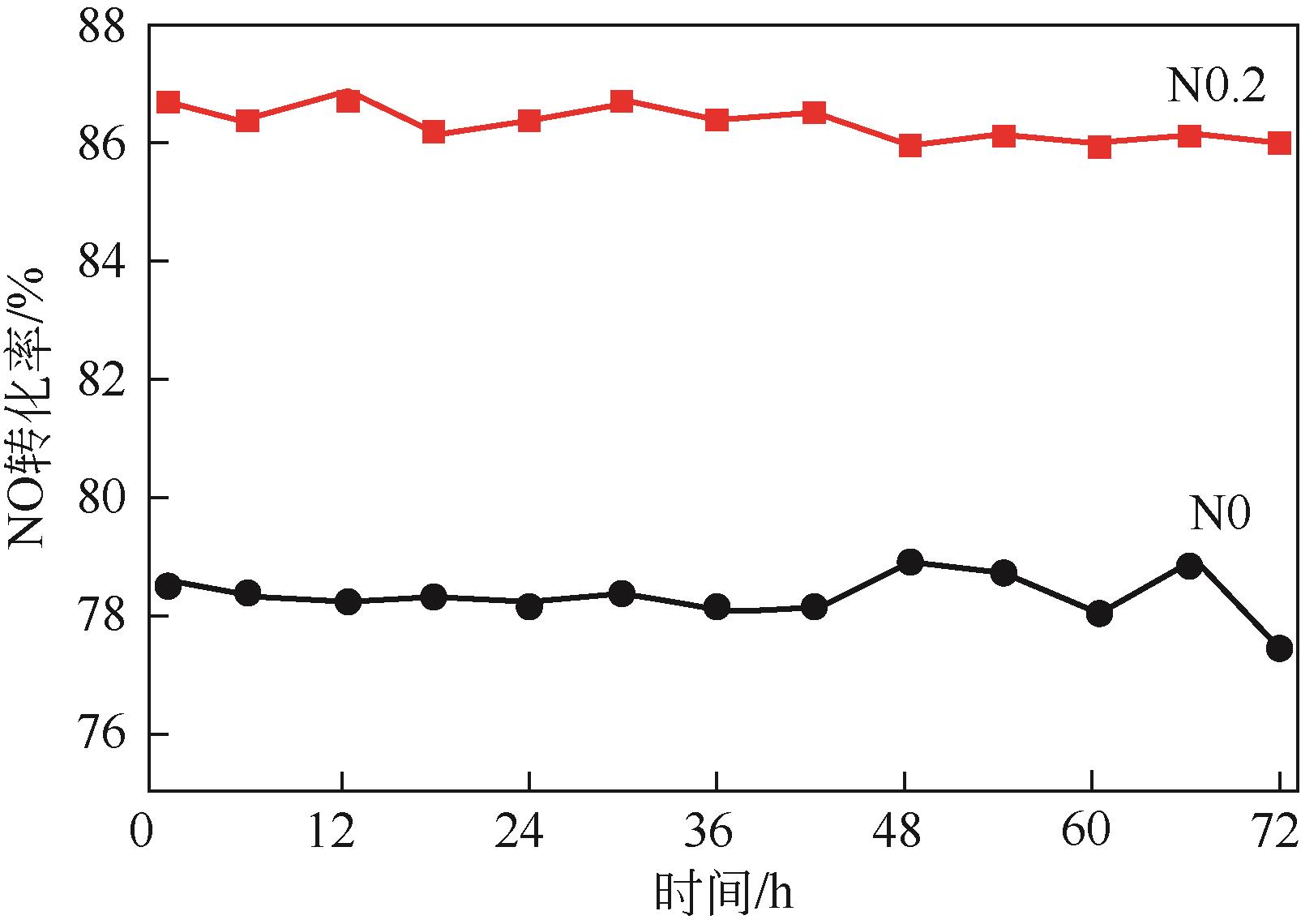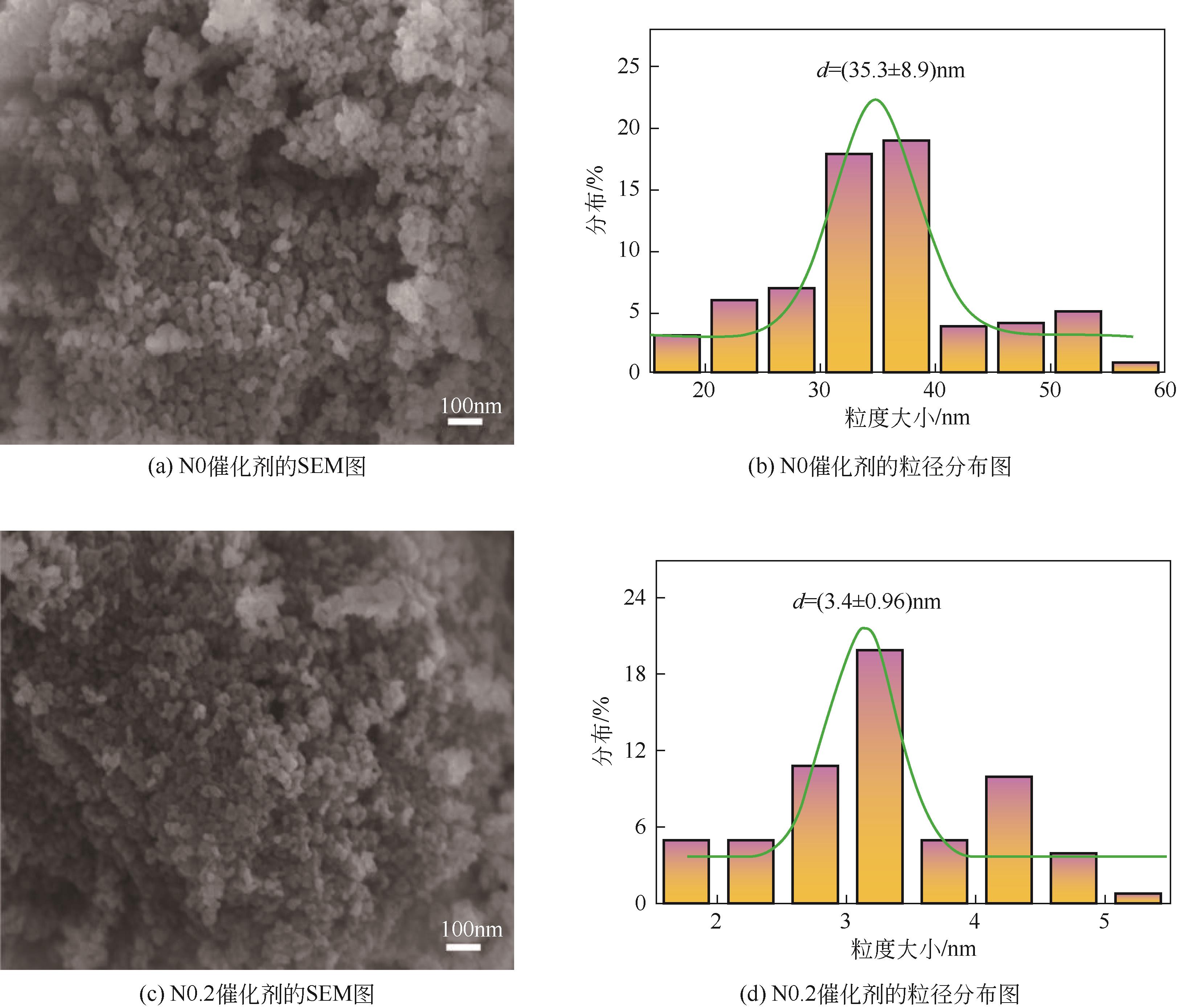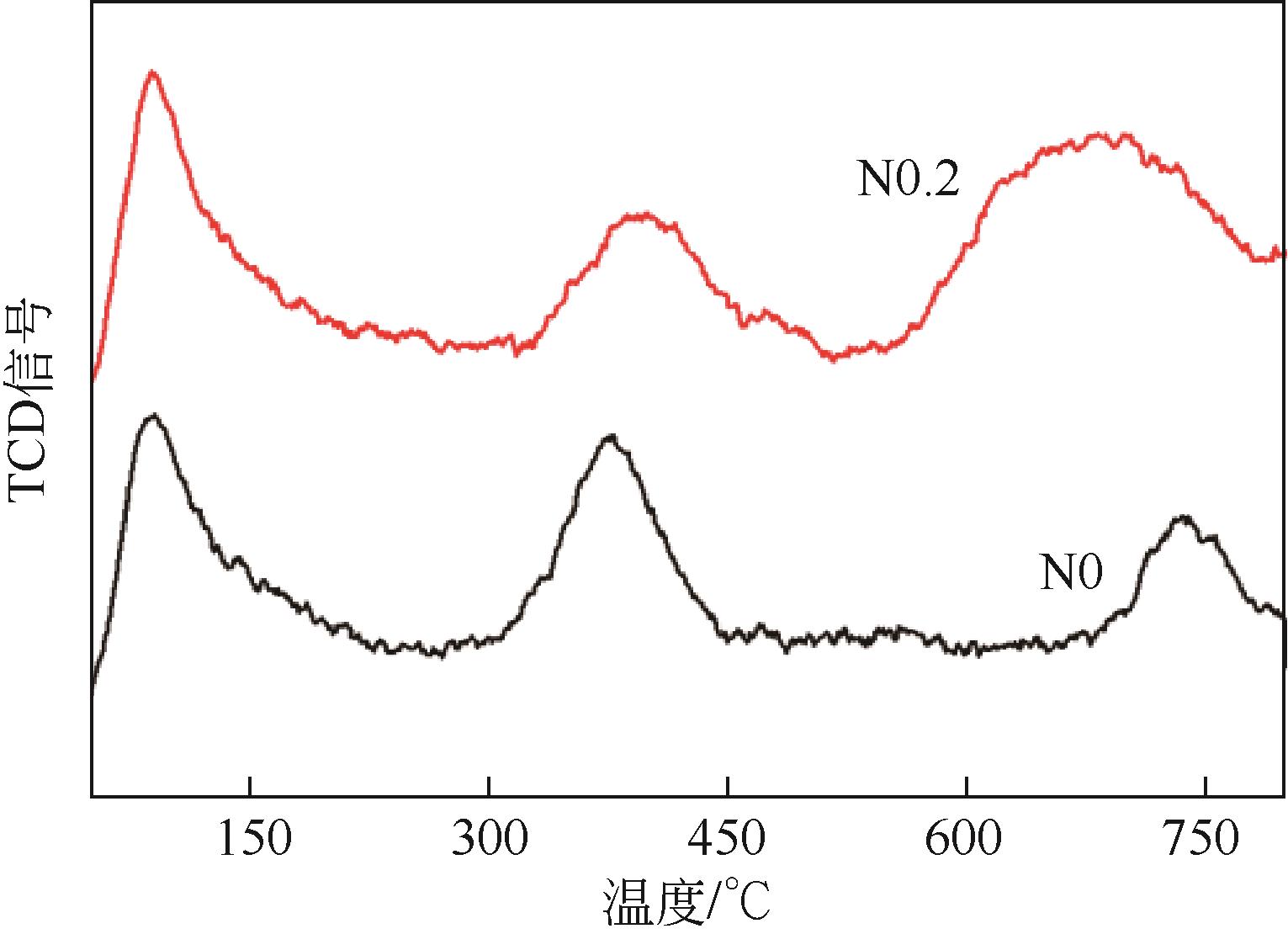化工进展 ›› 2023, Vol. 42 ›› Issue (11): 5747-5755.DOI: 10.16085/j.issn.1000-6613.2022-2312
氮掺杂钒钛蜂窝式催化剂低温脱硝性能
王露珠1( ), 安家康1, 张涛2, 邓立峰2, 任英杰2, 李扬2, 李涛1(
), 安家康1, 张涛2, 邓立峰2, 任英杰2, 李扬2, 李涛1( ), 任保增1
), 任保增1
- 1.郑州大学化工学院,河南 郑州 450001
2.江苏龙净科杰环保技术有限公司,江苏 盐城 224000
-
收稿日期:2022-12-13修回日期:2023-02-20出版日期:2023-11-20发布日期:2023-12-15 -
通讯作者:李涛 -
作者简介:王露珠(1993—),女,硕士研究生,研究方向为低温脱硝催化剂。E-mail:wanglz6201@163.com。 -
基金资助:河南省重大科技攻关项目(221100320100)
Catalytic performance of N-doped vanadium-titanium honeycomb catalysts at low temperature
WANG Luzhu1( ), AN Jiakang1, ZHANG Tao2, DENG Lifeng2, REN Yingjie2, LI Yang2, LI Tao1(
), AN Jiakang1, ZHANG Tao2, DENG Lifeng2, REN Yingjie2, LI Yang2, LI Tao1( ), REN Baozeng1
), REN Baozeng1
- 1.Chemical Engineering Institute, Zhengzhou University, Zhengzhou 450001, Henan, China
2.Jiang Su Longkingcotech Environmental Protection Technology Co. , Ltd. , Yancheng 224000, Jiangsu, China
-
Received:2022-12-13Revised:2023-02-20Online:2023-11-20Published:2023-12-15 -
Contact:LI Tao
摘要:
为了提升催化剂的低温脱硝性能,利用挤出成型法制备了一系列氮掺杂钒钛蜂窝式催化剂,考察了氮掺杂量对催化剂低温脱硝性能的影响及其稳定性,并通过XRD、BET、SEM、XPS、H2-TPR、NH3-TPD和O2-TPD等分析方法表征催化剂。结果表明:氮掺杂钒钛催化剂的低温脱硝性能显著提高,在140~200℃温度区间催化剂的脱硝性能良好,其中以氮钛摩尔比为0.2的催化剂具有最优的脱硝效果,并在200℃连续72h的稳定性测试过程中,表现出了良好的脱硝稳定性。氮掺杂能够使钒钛催化剂颗粒粒径变小,比表面积和孔容增大,表面V4+和化学吸附氧Oα的比率增加,表面酸性位点数量增加,使催化剂表面NH3吸附能力增强,氧化还原能力提高,促进了催化剂低温脱硝性能的提升。
中图分类号:
引用本文
王露珠, 安家康, 张涛, 邓立峰, 任英杰, 李扬, 李涛, 任保增. 氮掺杂钒钛蜂窝式催化剂低温脱硝性能[J]. 化工进展, 2023, 42(11): 5747-5755.
WANG Luzhu, AN Jiakang, ZHANG Tao, DENG Lifeng, REN Yingjie, LI Yang, LI Tao, REN Baozeng. Catalytic performance of N-doped vanadium-titanium honeycomb catalysts at low temperature[J]. Chemical Industry and Engineering Progress, 2023, 42(11): 5747-5755.
| 样品 | 比表面积/m2·g-1 | 孔容/cm3·g-1 | 平均孔径/nm |
|---|---|---|---|
| N0 | 60.9 | 0.28 | 16.99 |
| N0.1 | 61.5 | 0.28 | 16.14 |
| N0.2 | 63.7 | 0.29 | 16.36 |
| N0.3 | 59.1 | 0.26 | 16.31 |
表1 不同催化剂的结构特性
| 样品 | 比表面积/m2·g-1 | 孔容/cm3·g-1 | 平均孔径/nm |
|---|---|---|---|
| N0 | 60.9 | 0.28 | 16.99 |
| N0.1 | 61.5 | 0.28 | 16.14 |
| N0.2 | 63.7 | 0.29 | 16.36 |
| N0.3 | 59.1 | 0.26 | 16.31 |
| 样品 | Oα/(Oα+Oβ) | V4+/(V4++V5+) |
|---|---|---|
| N0 | 38.7% | 5.67% |
| N0.2 | 44.1% | 45.0% |
表2 不同催化剂表面不同O和V原子浓度之比
| 样品 | Oα/(Oα+Oβ) | V4+/(V4++V5+) |
|---|---|---|
| N0 | 38.7% | 5.67% |
| N0.2 | 44.1% | 45.0% |
| 1 | XU Junqiang, ZOU Xianlin, CHEN Guorong, et al. Tailored activity of Ce—Ni bimetallic modified V2O5/TiO2 catalyst for NH3-SCR with promising wide temperature window[J]. Vacuum, 2021, 191: 110384. |
| 2 | 周佳丽, 马子然, 赵俊平, 等. 杂多酸改性V-Mo/Ti-W催化剂的宽温SCR脱硝性能[J]. 化工进展, 2022, 41(7): 3615-3623. |
| ZHOU Jiali, MA Ziran, ZHAO Junping, et al. HPAs-modified V-Mo/Ti-W catalysts for the selective catalytic reduction of NO x over a wide temperature range[J]. Chemical Industry and Engineering Progress, 2022, 41(7): 3615-3623. | |
| 3 | 王韵杰, 张少君, 郝吉明. 中国大气污染治理: 进展·挑战·路径[J]. 环境科学研究, 2019, 32(10): 1755-1762. |
| WANG Yunjie, ZHANG Shaojun, HAO Jiming. Air pollution control in China: Progress, challenge and future pathways[J]. Research of Environmental Sciences, 2019, 32(10): 1755-1762. | |
| 4 | XU Guangyan, LI Hao, YU Yunbo, et al. Dynamic change of active sites of supported vanadia catalysts for selective catalytic reduction of nitrogen oxides[J]. Environmental Science & Technology, 2022, 56(6): 3710-3718. |
| 5 | 戴豪波, 陈瑶姬, 方华, 等. 非电行业钒基催化剂SCR脱硝研究进展[J]. 广州化工, 2020, 48(24): 29-33. |
| DAI Haobo, CHEN Yaoji, FANG Hua, et al. Research progress on SCR deNO x of vanadium-based catalysts in non-coal fired power industries[J]. Guangzhou Chemical Industry, 2020, 48(24): 29-33. | |
| 6 | 张道军, 马子然, 王宝冬, 等. SCR脱硝技术在非电行业烟气治理中的应用进展[J]. 现代化工, 2019, 39(10): 24-28. |
| ZHANG Daojun, MA Ziran, WANG Baodong, et al. Progress in application of SCR denitrification technology in treating flue gas of non-electric industries[J]. Modern Chemical Industry, 2019, 39(10): 24-28. | |
| 7 | ZHANG Shule, ZHONG Qin, ZHAO Wei, et al. Surface characterization studies on F-doped V2O5/TiO2 catalyst for NO reduction with NH3 at low-temperature[J]. Chemical Engineering Journal, 2014, 253: 207-216. |
| 8 | ZHANG Shule, ZHONG Qin. F-Doped V2O5-WO3/TiO2 as a catalyst for NO reduction with NH3 at low-temperature[J]. International Journal of Environmental Science and Development, 2012. DOI: 10.7763/IJESD. 2012. V3 263 . |
| 9 | ZHAO Wei, ZHONG Qin, ZHANG Tianjiao, et al. Characterization study on the promoting effect of F-doping V2O5/TiO2 SCR catalysts[J]. RSC Advances, 2012, 2(20): 7906-7914. |
| 10 | ZHAO Wei, ZHONG Qin, PAN Yanxiao, et al. Systematic effects of S-doping on the activity of V2O5/TiO2 catalyst for low-temperature NH3-SCR[J]. Chemical Engineering Journal, 2013, 228: 815-823. |
| 11 | 甘丽娜. 低温V2O5-WO3/TiO2脱硝催化剂开发与应用研究[D]. 北京: 中国科学院研究生院(过程工程研究所), 2016. |
| GAN Lina. Development of V2O5-WO3/TiO2 catalyst and its application in NH3-SCR of NOx at low temperatures[D]. Beijing: Institute of Process Engineering, Chinese Academy of Sciences, 2016. | |
| 12 | 梁全明. 耐硫抗水型低温SCR脱硝催化剂研究[D]. 北京: 北京工业大学, 2018. |
| LIANG Quanming. Research on low temperature SCR de-NO x catalyst with sulfur and water-resistance[D]. Beijing: Beijing University of Technology, 2018. | |
| 13 | 崔晶, 黄华存, 董文华, 等. F掺杂改性及其制备方法优化对V2O5-WO3/TiO2催化剂低温SCR脱硝性能的影响[J]. 环境工程学报, 2018, 12(11): 3139-3152. |
| CUI Jing, HUANG Huacun, DONG Wenhua, et al. Influence of F-doping modification and preparation method optimization of V2O5-WO3/TiO2 catalyst on its NO reduction at low temperature[J]. Chinese Journal of Environmental Engineering, 2018, 12(11): 3139-3152. | |
| 14 | 李航航, 赵炜, 王谦, 等. B改性钒钛催化剂低温NH3-SCR还原NO x [J]. 分子催化, 2021, 35(2): 121-129. |
| LI Hanghang, ZHAOWei, WANG Qian, et al. Boron-modified vanadia/titania catalyst for low-temperature NH3-SCR of NO x [J]. Journal of Molecular Catalysis (China), 2021, 35(2): 121-129. | |
| 15 | HUANG Li, ZENG Yiqing, GAO Yibo, et al. Promotional effect of phosphorus addition on improving the SO2 resistance of V2O5-MoO3/TiO2 catalyst for NH3-SCR of NO[J]. Journal of Physics and Chemistry of Solids, 2022, 163: 110566. |
| 16 | 李红玉. N掺杂TiO2载体的低温SCR催化剂的制备、性能及作用机制的研究[D]. 南京: 南京理工大学, 2013. |
| LI Hongyu. Study on the preparation, performance and its mechanism of low-temperature SCR catalysts loaded N-doped TiO2 [D]. Nanjing: Nanjing University of Science & Technology, 2012. | |
| 17 | PUTLURU Siva Sankar Reddy, JENSEN Anker Degn, RIISAGER Anders, et al. Heteropoly acid promoted V2O5/TiO2 catalysts for NO abatement with ammonia in alkali containing flue gases[J]. Catalysis Science & Technology, 2011, 1(4): 631-637. |
| 18 | MA Zhudong, Li Jian, ZHANG Ling, et al. Denitrification activities of Mo-V-Ti catalysts prepared by dipping method at low temperature[J]. Materials Science Forum, 2018, 913: 893-899. |
| 19 | WANG Chizhong, YANG Shijian, CHANG Huazhen, et al. Dispersion of tungsten oxide on SCR performance of V2O5-WO3/TiO2: Acidity, surface species and catalytic activity[J]. Chemical Engineering Journal, 2013, 225: 520-527. |
| 20 | PENG Feng, CAI Lingfeng, HUANG Lei, et al. Preparation of nitrogen-doped titanium dioxide with visible-light photocatalytic activity using a facile hydrothermal method[J]. Journal of Physics and Chemistry of Solids, 2008, 69(7): 1657-1664. |
| 21 | KWON Dong Wook, PARK Kwang Hee, HONG Sung Chang. Enhancement of SCR activity and SO2 resistance on VO x /TiO2 catalyst by addition of molybdenum[J]. Chemical Engineering Journal, 2016, 284: 315-324. |
| 22 | CHENG Kai, LIU Jian, ZHAO Zhen, et al. Direct synthesis of V-W-Ti nanoparticle catalysts for selective catalytic reduction of NO with NH3 [J]. RSC Advances, 2015, 5(56): 45172-45183. |
| 23 | ZHAO Xuteng, YAN Yongyi, MAO Lei, et al. A relationship between the V4+/V5+ ratio and the surface dispersion, surface acidity, and redox performance of V2O5-WO3/TiO2 SCR catalysts[J]. RSC Advances, 2018, 8(54): 31081-31093. |
| 24 | 白洋. V2O5(MO x )/TiO2脱硝催化剂表面V4+(3+)/V5+比值与活性关系[D]. 哈尔滨: 哈尔滨工程大学, 2016. |
| BAI Yang. Relationship between the denitration activity and the V4+(3+)/V5+ ratio of V2O5(MO x )/TiO2 catalyst [D]. Harbin: Harbin Engineering University, 2016. | |
| 25 | 段瑞瑞. V4+/V5+比值调变影响因素及其V4+和V5+转化的氧化还原速率与SCR脱硝活性[D]. 哈尔滨: 哈尔滨工程大学, 2014. |
| DUAN Ruirui. Influences on modulation of the V4+/V5+ ratio and rate of V4+ and V5+ redox and SCR DeNO x activity[D]. Harbin: Harbin Engineering University, 2014. | |
| 26 | ZHAO Xin, HUANG Lei, LI Hongrui, et al. Highly dispersed V2O5/TiO2 modified with transition metals (Cu, Fe, Mn, Co) as efficient catalysts for the selective reduction of NO with NH3 [J]. Chinese Journal of Catalysis, 2015, 36(11): 1886-1899. |
| 27 | YU Wenchao, WU Xiaodong, SI Zhichun, et al. Influences of impregnation procedure on the SCR activity and alkali resistance of V2O5-WO3/TiO2 catalyst[J]. Applied Surface Science, 2013, 283: 209-214. |
| 28 | YE Bora, LEE Myeung-jin, CHUN Seung-yeop, et al. Promotional effect of surface treated N-TiO2 as support for VO x -based catalysts on the selective catalytic reduction of NO using NH3 [J]. Applied Surface Science, 2021, 560: 149934. |
| 29 | CHMIELARZ L, DZIEMBAJ R, GRZYBEK T, et al. Pillared smectite modified with carbon and Manganese as catalyst for SCR of NO x with NH3. Part II. Temperature-programmed studies[J]. Catalysis Letters, 2000, 70(1): 51-56. |
| 30 | WANG Jinxiu, YI Xianfang, SU Qingfa, et al. Effect of FeO x and MnO x doping into the CeO2-V2O5/TiO2 nanocomposite on the performance and mechanism in selective catalytic reduction of NO x with NH3 [J]. Catalysis Science & Technology, 2021, 11(8): 2852-2863. |
| 31 | MARTÍN-MARTÍN J A, GALLASTEGI-VILLA M, GONZÁLEZ-MARCOS M P, et al. Bimodal effect of water on V2O5/TiO2 catalysts with different vanadium species in the simultaneous NO reduction and 1,2-dichlorobenzene oxidation[J]. Chemical Engineering Journal, 2021, 417: 129013. |
| 32 | ZHU Junjiang, ZHAO Zhen, XIAO Dehai, et al. Study of La2- x Sr x CuO4 (x=0.0, 0.5, 1.0) catalysts for NO+CO reaction from the measurements of O2-TPD, H2-TPR and cyclic voltammetry[J]. Journal of Molecular Catalysis A: Chemical, 2005, 238(1/2): 35-40. |
| 33 | XUE Li, ZHANG Changbin, HE Hong, et al. Catalytic decomposition of N2O over CeO2 promoted Co3O4 spinel catalyst[J]. Applied Catalysis B: Environmental, 2007, 75(3/4): 167-174. |
| 34 | ZHAO Zhen, YANG Xiangguang, WU Yue. Comparative study of Nickel-based perovskite-like mixed oxide catalysts for direct decomposition of NO[J]. Applied Catalysis B: Environmental, 1996, 8(3): 281-297. |
| 35 | 郭家秀, 史雪珂, 范爱东, 等. Ce改性锰酸镧催化剂的制备及脱硝性能研究[J]. 工程科学与技术, 2021, 53(4): 233-239. |
| GUO Jiaxiu, SHI Xueke, FAN Aidong, et al. Study on the preparation and denitration performance of Ce modified La-Mn perovskite catalyst[J]. Advanced Engineering Sciences, 2021, 53(4): 233-239. | |
| 36 | ZHANG Shule, LI Hongyu, ZHONG Qin. Promotional effect of F-doped V2O5-WO3/TiO2 catalyst for NH3-SCR of NO at low-temperature[J]. Applied Catalysis A: General, 2012, 435: 156-162. |
| [1] | 李艳玲, 卓振, 池亮, 陈曦, 孙堂磊, 刘鹏, 雷廷宙. 氮掺杂生物炭的制备与应用研究进展[J]. 化工进展, 2023, 42(7): 3720-3735. |
| [2] | 蒋博龙, 崔艳艳, 史顺杰, 常嘉城, 姜楠, 谭伟强. 过渡金属Co3O4/ZnO-ZIF氧还原催化剂Co/Zn-ZIF模板法制备及其产电性能[J]. 化工进展, 2023, 42(6): 3066-3076. |
| [3] | 张巍, 秦川, 谢康, 周运河, 董梦瑶, 李婕, 汤云灏, 马英, 宋健. H2-SCR改性铂系催化剂低温脱硝的应用及性能强化挑战[J]. 化工进展, 2023, 42(6): 2954-2962. |
| [4] | 何晨露, 邱晨茜, 方娟, 杨旋, 赖建军, 郑新宇, 吕建华, 陈燕丹, 黄彪. 基于低共熔溶剂体系的氮掺杂超级电容炭[J]. 化工进展, 2022, 41(9): 4946-4953. |
| [5] | 张爱京, 江胜娟, 周明正, 柴茂荣, 张劲. 纳米管壁数对氮掺杂碳纳米管氧还原反应活性的影响[J]. 化工进展, 2022, 41(4): 2038-2045. |
| [6] | 黄鑫, 刘成, 唐如佳, 韩欣欣, 陈世霞, 王珺. 氮掺杂碳限域的花状SnS催化CO2电还原制甲酸[J]. 化工进展, 2022, 41(11): 5887-5895. |
| [7] | 鞠梦灿, 严丽丽, 简铃, 江思雨, 饶品华, 李光辉. 氮掺杂生物炭材料的制备及其在环境中的应用[J]. 化工进展, 2022, 41(10): 5588-5598. |
| [8] | 张燕, 王淼, 赵佳辉, 冯宇, 米杰. 氮掺杂石墨烯/碳纳米管/无定形炭复合材料制备及其电化学性能[J]. 化工进展, 2022, 41(10): 5501-5509. |
| [9] | 秦晓伟, 张国杰, 李晟, 郭晓菲, 阎煌煜, 徐英, 刘俊. 非金属氮掺杂活性炭催化剂制备及其催化CH4-CO2重整反应[J]. 化工进展, 2021, 40(6): 3203-3214. |
| [10] | 邓秀春, 卓祖优, 白小杰, 孙杰, 陈燕丹. 银耳菌糠衍生的三维多级孔炭及其电化学应用性能[J]. 化工进展, 2021, 40(10): 5642-5651. |
| [11] | 唐彤, 杨永见, 万祖德, 池少聪, 赵攀, 黄文凤, 李明. 15000m3/h耐火材料厂焙烧窑炉烟气低温脱硝工程实验[J]. 化工进展, 2020, 39(S2): 401-405. |
| [12] | 刘清浩, 何艳飞, 梁丽娜, 念继鹏, 胡志勇, 郭金春, 梁栋, 刘红彦. 基于氮掺杂碳量子点的荧光微球制备和Fe3+检测[J]. 化工进展, 2018, 37(10): 3936-3942. |
| [13] | 李月华, 张蓉, 姜孟秀, 王文洋. 氮掺杂石墨烯负载八面体氧化亚铜复合材料的制备及其电催化性能[J]. 化工进展, 2017, 36(09): 3316-3322. |
| [14] | 胡小波, 袁伟杰, 朱秋莲, 陈银飞, 卢晗锋. 3-甲基吡啶一步气相氧化合成烟酸的V2O5/TiO2催化剂研究进展[J]. 化工进展, 2016, 35(04): 1101-1106. |
| [15] | 张德懿, 雷龙艳, 尚永花. 氮掺杂对碳材料性能的影响研究进展[J]. 化工进展, 2016, 35(03): 831-836. |
| 阅读次数 | ||||||
|
全文 |
|
|||||
|
摘要 |
|
|||||











